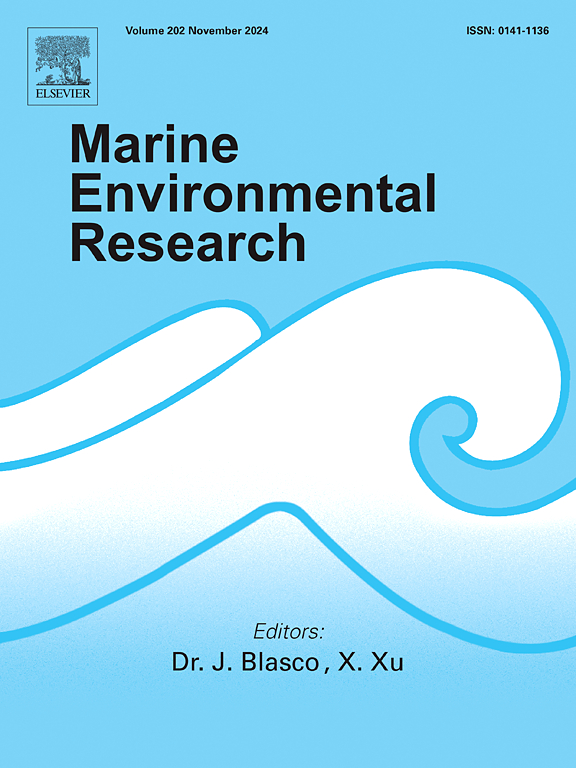海洋大型藻类微生物群落对夜间人工光照和适度升温条件的有限响应
IF 3.2
3区 环境科学与生态学
Q2 ENVIRONMENTAL SCIENCES
引用次数: 0
摘要
夜间人造光(ALAN)和气候变暖等多重压力源在海洋系统中越来越普遍,并且可以以复杂的方式相互作用。微生物群落在沿海生境形成物种(如海藻)的功能中起着至关重要的作用,但ALAN对海藻相关微生物群落的影响尚不清楚。我们测试了ALAN和变暖对与生境形成海藻Ecklonia radiata和Sargassum sp相关的微生物群落的独立和联合影响。在Ecklonia中,ALAN增加了两个潜在光响应分类群的相对丰度:Dokdonia sp000212355和来自Pseudomonadales的未知ASV,而变暖则相反。变暖增加了Ecklonia中微生物群落的分散,导致假定的致病和溶藻分类群(能够降解藻类多糖的微生物)的相对丰度无显著增加。然而,需要使用宏基因组学进一步分析来确认功能作用。相比之下,ALAN和变暖都没有影响与马尾藻相关的优势类群。与预期相反,尽管蓝藻具有光合能力,但其相对丰度并未受到海藻宿主ALAN的影响。我们发现ALAN和变暖交互作用的证据有限,两种海藻的群落组成保持不变。我们的研究结果强调了考虑物种特异性微生物对ALAN和变暖的反应的重要性,这对沿海管理具有启示意义。本文章由计算机程序翻译,如有差异,请以英文原文为准。
Limited microbial community responses of marine macroalgae to artificial light at night and moderate warming conditions
Multiple stressors such as Artificial Light at Night (ALAN) and warming are increasingly common in marine systems and can interact in complex ways. Microbial communities play critical roles in the functioning of coastal habitat-forming species such as seaweeds, however the effects of ALAN on seaweed-associated microbial communities remain unknown. We tested the independent and combined effects of ALAN and warming on microbial communities associated with the habitat-forming seaweeds Ecklonia radiata and Sargassum sp. In Ecklonia, ALAN increased the relative abundance of two potentially light-responsive taxa: Dokdonia sp000212355 and an unidentified ASV from Pseudomonadales, whereas warming had the opposite effect. Warming increased microbial community dispersion in Ecklonia and resulted in non-significant increases in relative abundance of putative pathogenic and agarolytic taxa (microbes capable of degrading algal polysaccharides). However, further analyses using metagenomics are needed to confirm functional roles. In contrast, neither ALAN nor warming affected dominant taxa associated with Sargassum. Contrary to expectations, cyanobacteria relative abundance was unaffected by ALAN in either seaweed host, despite their photosynthetic capacity. We found limited evidence for interactive effects of ALAN and warming, and community composition remained unchanged in both seaweed species. Our findings highlight the importance of considering species-specific microbial responses to ALAN and warming, with implications for coastal management.
求助全文
通过发布文献求助,成功后即可免费获取论文全文。
去求助
来源期刊

Marine environmental research
环境科学-毒理学
CiteScore
5.90
自引率
3.00%
发文量
217
审稿时长
46 days
期刊介绍:
Marine Environmental Research publishes original research papers on chemical, physical, and biological interactions in the oceans and coastal waters. The journal serves as a forum for new information on biology, chemistry, and toxicology and syntheses that advance understanding of marine environmental processes.
Submission of multidisciplinary studies is encouraged. Studies that utilize experimental approaches to clarify the roles of anthropogenic and natural causes of changes in marine ecosystems are especially welcome, as are those studies that represent new developments of a theoretical or conceptual aspect of marine science. All papers published in this journal are reviewed by qualified peers prior to acceptance and publication. Examples of topics considered to be appropriate for the journal include, but are not limited to, the following:
– The extent, persistence, and consequences of change and the recovery from such change in natural marine systems
– The biochemical, physiological, and ecological consequences of contaminants to marine organisms and ecosystems
– The biogeochemistry of naturally occurring and anthropogenic substances
– Models that describe and predict the above processes
– Monitoring studies, to the extent that their results provide new information on functional processes
– Methodological papers describing improved quantitative techniques for the marine sciences.
 求助内容:
求助内容: 应助结果提醒方式:
应助结果提醒方式:


